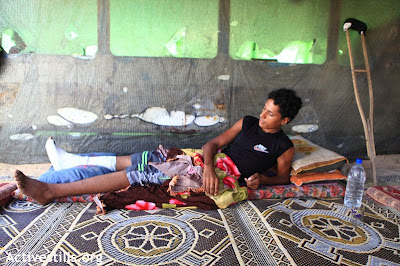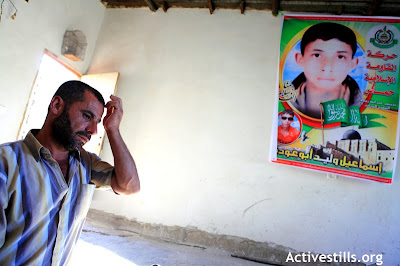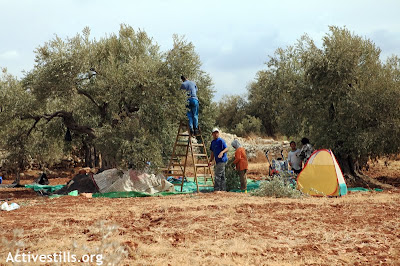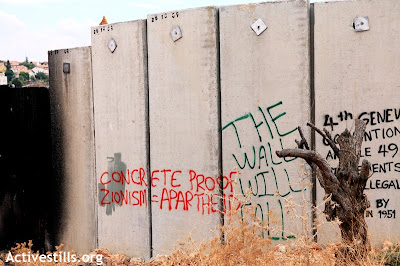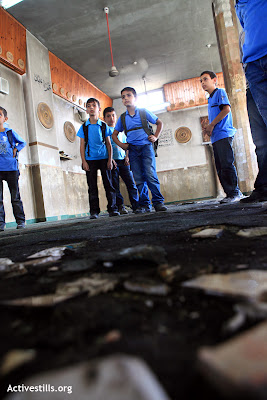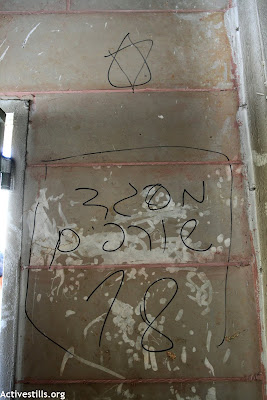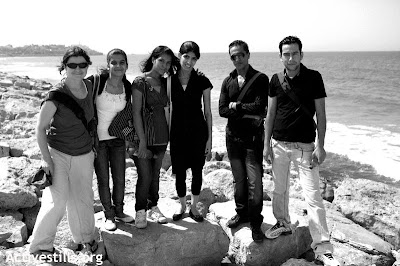
(c) Anne Paq/Activestills.org, Gaza, 24.10.2010
The Siege Kills !! - Another Silent Victim Dies in Gaza.
Nisma Aby Lasheen, a two-year old toddler, died in the Gaza Strip on October16, 2010. The wait for a permit to travel to Israel for urgent treatment, had been too long. The permission for transfer was requested on September 28 and on October 6, the family was informed that there would be some delay. The reason given for the delay was that the Israeli authorities requested that Nisma was to be be accompanied by her mother and not her father. Although her mother had given birth only 3 months earlier, she was not in healthy enough to travel. Finally, permission to travel was given on October 14, but the doctors declared that Nisma would not survive the trip. Her condition had only worsened in those critical days. She died two days later, in the arms of her father, who then asked: “Do those responsible for the occupation have no children?.”
Nisma became ill when she was a year and a half old. First treated in a hospital in Gaza, it soon became clear that she needed to undergo further tests, unavailable in the Gaza Strip. She was first transfered to Al Maqassed in Jerusalem, accompanied by her pregnant mother. She was then transferred to Ichilof hospital in Tel Aviv, where she was diagnosed with stage 4 leukemia. Her mother gave birth in the same hospital, in Tel Aviv. Her father was then allowed to join them to replace her mother. They stayed in the hospital for three more weeks before going back to Gaza on July 28, 2010. However Nisma’s situation did not improve and she had to stay in a hospital in Gaza to receive further treatment. On September 14, another travel request was submitted to the Israeli authorities. Her father managed to take her, on the same day, to the Haemec Medical Center in Afula, in order to undergo intensive chemotherapy, which is not available in the Gaza Strip. They came back on the 22 September, but her situation continued to deteriorate. Soon after, another request to travel to Israel for urgent medical treatment was delivered to with the Israeli authorities. The answer came too late, 17 days after the initial demand.
Nisma is only one case among many. Many services, specialists and life-saving treatments are not available to Palestinians inside the Gaza Strip, and since the siege began, access to medical care in hospitals outside Gaza has become more difficult. Delays of medical cases, even urgent cases for which every hour can be a matter of life and death, must go through strenuous and bureaucratic procedures. The demand must be first addressed to the Gaza Coordinating Authority (Matak Gaza) which then transfers the cases to the Palestinian Authority Health Authorities in Ramallah which in turn sends the requests to the Israeli authorities. Patients’ exits from the Gaza Strip into Israel are also subject to frequent closures of the crossing points. In September 2010, Erez crossing was closed for a total of 12 days. According to the World Health organization, September saw the highest number of cases delayed in the last four-month period. 80 cases were delayed and 14 were denied out of the 626 applications. One of the practices of Israeli authorities denounced by international organizations is to require some patients who asks for referrals to come to Eerz for interrogations during which some come under pressure to become collaborators (see report of the Israeli organization Physicians for Human Rights, Holding Health to carry a Ransom: GSS Interrogation and Extortion of Palestinian Patients at Erez Crossing). Thus, in September, out of 80 cases that were delayed, 15 patients were called for interrogation. Since the beginning of 2009, 32 patients have died before being able to access the hospital they were referred to, due to lack of permits or delays.
Nisma’s father has no doubt about who is responsible: : “the occupation- the occupyiers are like the hunters who shot the birds; and the birds are the children of Gaza”. International humanitarian law is also very clear on the matter. One of the core principles is that the Occupying power is responsible for the well-being of the civilians and the welfare of the children.
Nisma's father intends to bring the case to Israeli courts to hold the ones responsible for his daughter’s death, and shed light on this critical issue, for hundreds more sick people in the Gaza Strip,still waiting for their permits to be approved.
Many questions still need to be answered. Why had it taken 17 days to obtain an urgent request for a 2 year-old girl, to go to an Israeli hospital? Why do the Israeli authorities demand to change the identity of the person accompanying the child, while the same person was granted permission just weeks prior? How come the advanced Israeli security system is not able to treat such cases in just one day? But more importantly- How come the siege of Gaza and the Israeli occupation still continue ?
Nisma is not the victim of a “humanitarian crisis”, but of a policy, made by men with the complicity of the whole international community. According to her father, Nisma had learned how to say a few words: “mother”, “father” and “pain”. She is yet another silent victim, but I hope that the cry of her death screams louder than all the useless fuss about the meaningless so-called “negotiations”.
-------FRANCAIS-------------------------------------------------------------------------
Le siège tue-une autre victime est morte en silence à Gaza.
Nisma Aby Lasheen, un bébé de deux ans, est décédée dans la bande de Gaza le 16 Octobre 2010. La permission pour se rendre dans un hôpital en Israël afin de recevoir un traitement urgent est arrivée trop tard. L'autorisation de transfert a été demandée le 28 Septembre. Le 6 Octobre, on a notifié à la famille un certain retard. La raison invoquée était que les autorités israéliennes exigeait que Nisma soit accompagnée par sa mère et non son père. Cependant sa mère, qui avait accouché seulement 3 mois plus tôt n'était pas en mesure de voyager. Enfin, l'autorisation est arrivée le 14 Octobre. Mais les médecins ont déclaré que l'état de Nisma, qui s'était considérablement aggravé pendant ces journées critiques d'attente, ne survivrait pas au voyage. Elle est morte deux jours après, dans les bras de son père qui a alors demandé: «Mais les responsables de l'occupation n'ont-ils pas d'enfants?".
Nisma est tombée malade alors qu'elle avait un an et demi. Apres avoir été examinée dans un hôpital à Gaza, il est vite apparu qu'elle avait besoin de subir d'autres examens non disponibles dans la bande de Gaza. Elle a d'abord été transférée à l'hôpital Al Maqassed à Jérusalem, accompagnée de sa mère enceinte. De là, elle a été transférée à l'hôpital Ichilof à Tel-Aviv où on lui a diagnostiqué une leucémie. Sa mère a du accouché prématurément dans ce même hôpital. Son père a alors été autorisé à les rejoindre afin de remplacer la mère. Ils sont restés encore trois semaines avant de rentrer à Gaza le 28 Juillet 2010. Cependant sa situation ne s' est pas améliorée, et elle a dû rester dans un hôpital de Gaza pour recevoir des soins. Le 14 Septembre, une autre demande a été effectuée d'urgence et a abouti le jour même, permettant Nisma de se rendre au Centre médical Haemec à Afula afin de recevoir des séances de chimiothérapie intensive qui n'existe pas dans la bande de Gaza. Ils sont revenus à Gaza le 22 Septembre, mais la situation de Nisma a continué de se détériorer. Par conséquent, une autre demande d'urgence a été faite auprès des autorités israéliennes. La réponse est venue trop tard, avec un délai inexplicable de 17 jours après la demande initiale.
Nisma n'est qu'un cas parmi d'autres. De nombreux services, spécialistes et des traitements vitaux de santé ne sont pas disponibles pour les Palestiniens dans la bande de Gaza. De plus, depuis le début du siège, l'accès aux soins médicaux dans les hôpitaux en dehors de Gaza est devenu plus difficile. Les demandes de transferts des patients, même pour les cas urgents pour lesquels chaque heure peut être une question de vie ou de mort, doivent passer par des procédures lourdes. La demande doit d'abord être adressée à l'Autorité de coordination de Gaza (Matak Gaza) qui doit transférer les cas à l'Autorité palestinienne à Ramallah, qui à son tour envoie les demandes aux autorités israéliennes. Les sorties de patients sont également affectées par la fermeture fréquente des points de passage entre la bande de Gaza et Israël. Par exemple, lors du mois de Septembre 2010, le point de passage d'Erez a été fermée pendant 12 jours. Selon l'Organisation Mondiale de la Santé (OMS), Septembre a vu la plus forte proportion de cas de retard depuis les quatre derniers mois. Sur un total de 626 demandes en Septembre, 80 cas ont obtenu leurs autorisations avec retard, et 14 se sont vus refusés le droit de se rendre en Israël. Une des pratiques des autorités israéliennes dénoncées par les organisations internationales est d'exiger que certains patients de rendent à des interrogatoires pendant lesquels certains subissent des pressions notamment pour devenir des collaborateurs (voir le rapport de l'organisation israelienne Physicians for human Rights, PHR published a report Holding Health to Ransom: GSS Interrogation and Extortion of Palestinian Patients at Erez Crossing). Ainsi, en Septembre, sur les 80 cas qui ont subi des retards, 15 patients ont ete appelées pour un interrogatoire. Depuis le début de l'année 2009, 32 patients sont morts avant d'être en mesure d'accéder les hôpitaux pour lesquels ils avaient demandé un transfert.
Le père de Nisma n'a aucun doute sur la cause de la mort de sa fille: "l'occupation: les occupants sont comme chasseurs qui tirent sur les oiseaux et les oiseaux sont les enfants de Gaza". Le droit international humanitaire est également très clair sur la question-La puissance occupante est responsable du bien-être des civils et des enfants.
Le père de Nisma a l'intention de porter l'affaire devant les tribunaux israéliens afin que les responsables de la mort de sa fille soient punis et pour sensibiliser l'opinion et les institutions internationales sur cette question cruciale qui concerne des centaines de personnes malades dans la bande de Gaza en attente de leur permis.
Beaucoup de questions restent en suspens. Pourquoi il a fallu 17 jours pour obtenir une demande urgente pour une petite fille de 2 ans pour aller à un hôpital d'Israël? Pourquoi les autorités israéliennes ont réclamé un changement pour la personne accompagnante alors que son père avait déjà obtenu la même permission seulement quelques semaines auparavant? Comment se fait-il que l'appareil puissant de sécurité d'Israël ne peut pas traiter de tels cas, en une seule journée? Mais plus fondamentalement-comment se fait-il que le siège de Gaza et l'occupation israélienne puissent continuer en toute impunité ?
Nisma n'est pas la victime d'une "crise humanitaire", mais d'une politique, faite par des hommes avec la complicité de la communauté internationale tout entière. Selon son père, Nisma ne connaissait seulement que quelques mots: «mère», «père» et «douleur». Elle est une autre victime silencieuse, mais je souhaite que sa mort fasse plus de bruit que toute cette agitation inutile sur des négociations auxquelles plus personne ne croit.







